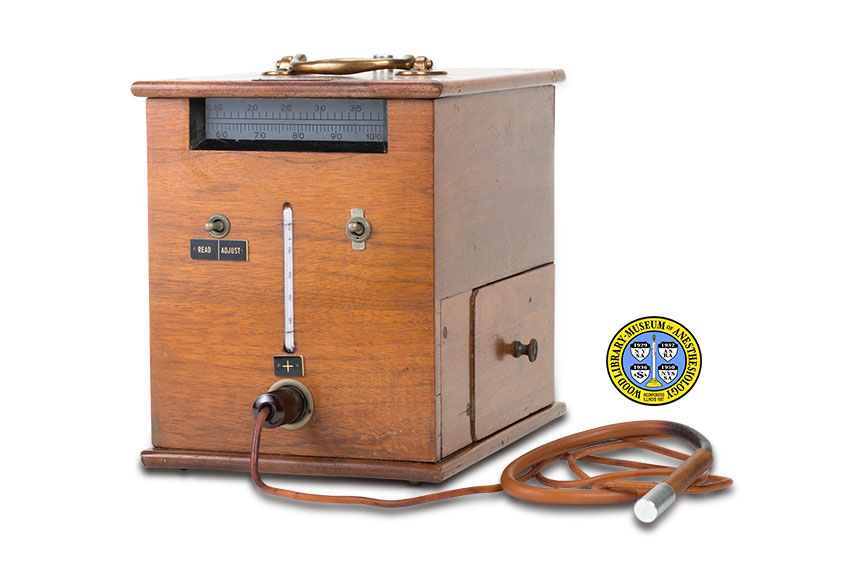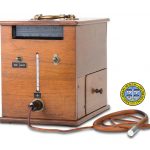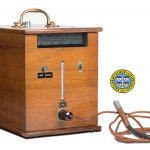U.M.A. Thermocouple
A thermocouple is a temperature-measuring sensor that consists of two different conducting metals that connect to each other at one or more points. This thermocouple had a connection inside the device, which functioned as the reference point for the room’s temperature. A second connection was located in the skin applicator at the end of a long cord. When the applicator was applied to a patient’s skin the disparity between the room’s temperature and the skin’s temperature resulted in a small voltage change. The change moved a mirror that reflected a beam of light on the horizontal temperature scale located on the front of the apparatus.
The U. M. A. Thermocouple shown here is believed to have been used in the 1950s by Emory A. Rovenstine, M.D. (1895-1960), at Bellevue Hospital in New York City. Dr. Rovenstine, a former resident of Ralph M. Waters, M.D., founded Bellevue’s Department of Anesthesiology in 1935. The device was used to measure the surface temperature of the patient’s skin after a sympathetic nerve block. An increase in the temperature of the skin over the area to be affected by the block would indicate that the block was effective.
Catalog Record: U.M.A. Thermocouple
Access Key: amdm
Accession No.: 2014-12-01-1
Title: U. M. A. [thermocouple].
Corporate Author: U. M. A., Inc.
Title variation: Alt Title
Title: U. M. A. thermocouple skin thermometer.
Publisher: New York, N.Y.: U. M. A., Inc., [between 1942 and 1959?].
Physical Descript: 1 thermometer : metals, wood, glass, rubber ; 26.5 x 21.5 x 30 cm.
Subject: Thermometers.
Subject: Temperature Measurement.
Subject: Monitoring – instrumentation.
Note Type: General
Notes: The title is based on an undated booklet on the device.
Note Type: General
Notes: The early year in the date range for the possible year of manufacture of this
U.M.A. Thermocouple is an estimate based on the dates of search results in
Google Books. The earliest publication that yielded a search for “U. M. A.
Thermocouple” was a 1942 issue of the Hebrew Medical Journal, in which an
advertisement for the devise was found. There were a large number of results
in the late 40s to early 1960s. Because this device was used by Dr. Emery A.
Rovenstine at Bellevue the end date for the possible year of manufacture
(1959) is based on the year of Dr. Rovenstine’s death, 1960. The date range
could change if documentation, or expert opinion, indicates that it should be
corrected.
Note Type: Acquisition
Notes: Email from the donor, Charles W. Buffington, M.D. Acquisition papers for
2014-12-01-01. Located at: Located at: Wood Library-Museum of Anesthesiology,
Schaumburg, Illinois.
Note Type: Citation
Notes: Bacon DR, Darwish H. Emery A. Rovenstine and regional anesthesia. Reg Anesth.
1997;22(3):273-279.
Note Type: Citation
Notes: MacKersey K, Nacht A. Bellevue Hospital: a place for teaching. Sphere.
2014;66(3):13-22. https://www.nyssa-pga.
org/wp-content/uploads/2014/09/Fall2014_Sphere-Web.pdf. Accessed June 30,
2015.
Note Type: Citation
Notes: Rovenstine, M.D. NYSSA Sphere. 1976;28(6):28-31.
Note Type: Citation
Notes: U. M. A. Thermocouple accepted. JAMA. July 15, 1950;143(11):971.
Note Type: Citation
Notes: The U. M. A. Thermocouple: A Diagnostic Instrument in Peripheral Vascular
Disease. New York: U. M. A. Inc.; [date of publication not indicated].
[Based on the style of the illustrations and font, the booklet it seems
likely that it was published sometime in the 1940s, 1950s or early 1960s.]
Note Type: Citation
Notes: The U. M. A. Thermocouple [advertisement]. Harofe´ haivri = Hebrew Med J.
1942;2:200.
Note Type: Physical Description
Notes: One skin thermometer in wooden housing; Cut into the top of the wooden front
are scales in both Celsius and Fahrenheit; Celsius is the upper scale and is
marked in increments of one with 15, 20, 25, 30, and 35 numbered; The lower
scale is Fahrenheit and is also marked in increments of one with 60, 70, 80,
90 and 100 numbered; On the left side of the front is a toggle switch; The
left position is labeled “READ” and the right is labeled “ADJUST”; On the
right side of the front is another toggle switch; The up position is labeled
“ON” and the down position is labeled “OFF”; A mercury glass thermometer is
affixed to the center of the front and is marked in Fahrenheit from 60 to
100; Below the mercury thermometer is a plastic plate marked with a plus sign
and below this is a is a plug for the sensor cord; On top is a brass
carrying handle and behind it is a metal rotating lever; The lever is not
marked; A metal plate with manufacturer markings is nailed to the front edge
of the top; The manufacturer markings include, “U. M. A., INC. [new line] NEW
YORK, N.Y. [new line] VOLTS 110 CURRENT ADC CYCLES [blank, new line] SERIAL
NO. 25563 MADE IN U.S.A.”; Held in a drawer on the right side of the device
is a long rubber covered sensor with the ‘male’ end for the plug on the front
of the device; Also stored in the drawer is a power cord; A connection for
the power cord is located on the back of the device; An circular orange and
yellow paper label that was on the bottom of the device has fallen off; Text
on the label includes, “APPROVED FOR ELECTRICAL SAFETY, DEPARTMENT OF
BUILDING & SAFETY, CITY OF LOS ANGELES, FOUNDED 1781″; The following black
letters and numbers have been stamped across the sticker, “BF009377”; The
sticker has been placed in an envelope and tucked under the rotating lever on
the top of the device.
Note Type: Reproduction
Notes: Photographed by Mr. Steve Donisch, January 12, 2015.
Note Type: Acquisition
Notes: Donated to the WLM by Charles W. Buffington, M.D.
Note Type: Historical
Notes: A thermocouple is a temperature-measuring sensor that consists of two different conducting metals that connect to each other at one or more points. This thermocouple had a connection inside the device, which functioned as the reference point for the room’s temperature. A second connection was located in the skin applicator at the end of a long cord. When the applicator was applied to a patient’s skin the disparity between the room’s temperature and the skin’s temperature resulted in a small voltage change. The change moved a mirror that reflected a beam of light on the horizontal temperature scale located on the front of the apparatus.
The U. M. A. Thermocouple shown here is believed to have been used in the 1950s by Emory A. Rovenstine, M.D. (1895-1960), at Bellevue Hospital in New York City. Dr. Rovenstine, a former resident of Ralph M. Waters, M.D., founded Bellevue’s Department of Anesthesiology in 1935. The device was used to measure the surface temperature of the patient’s skin after a sympathetic nerve block. An increase in the temperature of the skin over the area to be affected by the block would indicate that the block was effective.
Note Type: Publication
Notes: Hunt LB. The early history of the thermocouple. Platinum Metals Rev.
1964;8(1):23-28.
Note Type: Exhibition
Notes: Selected for the WLM website.



